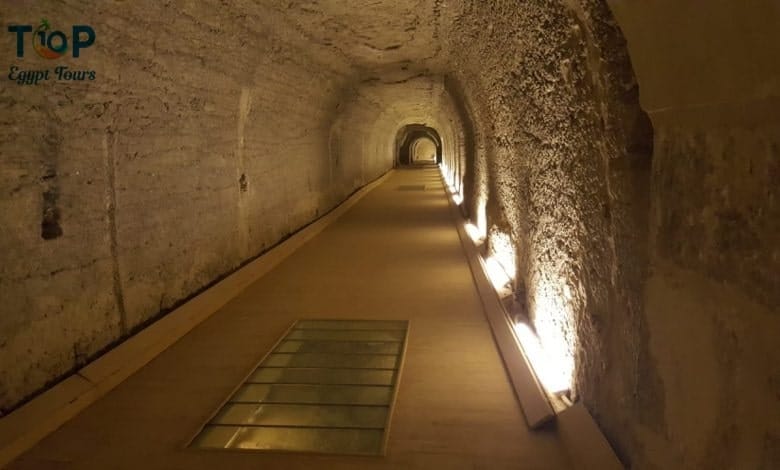The Serapeum of Saqqara is an ancient burial complex located in the necropolis of Saqqara, near Cairo, Egypt. It is a site of great archaeological and historical significance, known for its massive underground galleries that housed the sacred Apis bulls, revered as manifestations of the god Ptah and later associated with the god Serapis.
In this article, we will uncover for you the Serapeum of Saqqara with Top Ten Egypt.
Historical Background Of Serapeum of Saqqara:
The origins of the Serapeum date back to the time of the New Kingdom in ancient Egypt, specifically the reign of Amenhotep III (1390-1352 BCE). It was during this period that the Apis bull cult gained prominence, with the Apis bull being regarded as a living deity and symbol of the pharaoh’s power and divine connection.
Architecture and Design:
The Serapeum consists of a series of subterranean galleries, known as the “Apis galleries,” where the sacred bulls were buried. These galleries were excavated out of solid bedrock and were designed to provide a permanent resting place for the revered animals.
The galleries are characterized by their long corridors lined with massive granite sarcophagi, each weighing several tons. The sarcophagi were intricately carved and decorated, featuring depictions of the bull-god Apis and various religious motifs. The corridors were sealed with massive stone doors, further emphasizing the sacred and secretive nature of the site.
The Apis Bulls and Burial Rituals:
The Apis bulls were carefully chosen from the bull population in Egypt, believed to be divinely marked with specific physical attributes. Once identified, the bull was brought to the temple of Ptah in Memphis, where it received elaborate rituals and worship.
When an Apis bull died, it was embalmed with great care and placed in a specially prepared sarcophagus within the Serapeum. The burial process was accompanied by elaborate ceremonies and religious rituals, ensuring the bull’s transition into the realm of the gods.
Exploration and Rediscovery:
The Serapeum remained hidden for centuries until its rediscovery in 1850 by the French archaeologist Auguste Mariette. The site had been lost to history, buried under layers of sand and debris over the centuries.
Mariette’s excavation efforts revealed the grandeur and scale of the underground complex. He uncovered numerous sarcophagi and elaborate burial chambers, along with inscriptions and artifacts that provided important insights into the Apis bull cult and its significance in ancient Egyptian religious beliefs.
Significance and Legacy:
The Serapeum of Saqqara holds immense historical and religious significance. It served as a center for the worship of the Apis bull, representing the divine connection between the pharaoh and the gods in ancient Egyptian belief. The complex was a focal point for religious rituals, and its grandeur reflected the power and authority of the pharaohs.
The discovery and study of the Serapeum have deepened our understanding of ancient Egyptian religious practices, burial customs, and the role of animals in their belief system. The site continues to fascinate archaeologists, historians, and visitors alike, offering a glimpse into the rich and complex world of ancient Egyptian culture.
Visiting the Serapeum of Saqqara:
The Serapeum is open to visitors, allowing them to explore the underground galleries and witness the remarkable sarcophagi that once housed the sacred Apis bulls. However, due to the delicate nature of the site, access to certain areas may be restricted, and it is advisable to check with local authorities or tour operators for the most up-to-date information and guidelines.
When visiting the Serapeum, it is important to respect the historical and cultural significance of the site. Visitors should follow any rules or restrictions provided, avoid touching the ancient artifacts, and take care to preserve the integrity of this remarkable archaeological treasure.
Start an extraordinary Day Trip to Saqqara, and take yourself on a journey through time, unraveling the mysteries of ancient Egypt.
Conclusion:
The Serapeum of Saqqara stands as a testament to the religious beliefs and practices of ancient Egypt. Its underground galleries and intricate sarcophagi offer a glimpse into the veneration and worship of the Apis bulls, providing valuable insights into the spiritual world of the Rulers. A visit to the Serapeum is a journey into the ancient past, allowing us to appreciate the profound cultural heritage of Egypt and the enduring legacy of its religious traditions.



Comment (0)